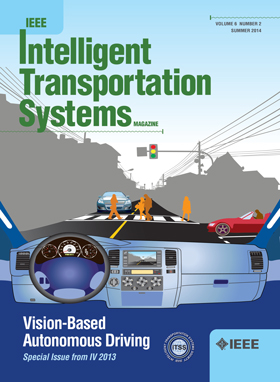Traffic Flow Crystallization Method for Trajectory Approximation and Lane Change Inference
IF 8.4
1区 工程技术
Q1 ENGINEERING, CIVIL
IEEE Transactions on Intelligent Transportation Systems
Pub Date : 2025-06-13
DOI:10.1109/TITS.2025.3572623
引用次数: 0
Abstract
Whereas on many motorways, traffic operations are permanently monitored, and long historical logs of such data exist, they are not directly usable for lane change studies, as they only register local passages and speeds. This study proposes a novel method to transform discrete vehicle passage records of individual vehicle data (IVD) into approximations of vehicle trajectories and inference of lane change maneuvers (LCMs), such that large-scale LCM dataset can be retrieved from existing infrastructures where IVD is recorded at sufficiently close spacings (~600 meters). The method’s core is a probabilistic re-identification of individual vehicles in successive, lane-specific loop detectors. Dubbed Traffic Flow Crystallization (TFC), the methodology enhances traffic monitoring by providing vast and diverse LCM datasets. It consists of two key re-identification (ReID) modules: a lane-restricted module that matches vehicles strictly within the same lane and a non-lane-restricted module that recursively identifies lane-changing vehicles using boundary conditions imposed by previously matched vehicles. This recursive process resembles crystal growth, inspiring the method’s name. The ReID methodology is based on a weighted likelihood function consisting of Bayesian probability estimators that integrate three similarity measures: vehicle length, passage time, and passage speed. A lane-change feasibility filter ensures that re-identified vehicles satisfy plausible spatiotemporal constraints. The final module resolves inconsistencies and infers LCMs. The proposed method is trained and validated using CCTV footage, where visually-identified vehicles serve as ground truth. Validation results demonstrate a vehicle ReID success rate exceeding 96% and an inferred LCM rate with only a 2% underestimation compared to ground truth.交通流结晶法的轨迹逼近与变道推理
然而,在许多高速公路上,交通运行是永久监控的,并且存在此类数据的长期历史记录,它们不能直接用于变道研究,因为它们只记录当地的通道和速度。本研究提出了一种新的方法,将单个车辆数据(IVD)的离散车辆通行记录转换为车辆轨迹的近似值和变道机动(LCM)的推断,这样就可以从现有的基础设施中检索大规模的LCM数据集,其中IVD记录在足够近的间隔(~600米)。该方法的核心是在连续的、车道特定的环路检测器中对单个车辆进行概率重新识别。该方法被称为交通流结晶(TFC),通过提供大量不同的LCM数据集来增强交通监控。它由两个关键的重新识别(ReID)模块组成:一个车道限制模块,严格匹配同一车道内的车辆;一个非车道限制模块,使用先前匹配车辆施加的边界条件递归识别变道车辆。这种递归过程类似于晶体生长,因此得名。ReID方法基于加权似然函数,该函数由贝叶斯概率估计器组成,该概率估计器集成了三个相似度量:车辆长度、通过时间和通过速度。变道可行性滤波器确保重新识别的车辆满足合理的时空约束。最后一个模块解决不一致并推断lcm。所提出的方法使用CCTV录像进行训练和验证,其中视觉识别的车辆作为地面真相。验证结果表明,车辆ReID成功率超过96%,推断的LCM率仅比实际情况低估2%。
本文章由计算机程序翻译,如有差异,请以英文原文为准。
求助全文
约1分钟内获得全文
求助全文
来源期刊

IEEE Transactions on Intelligent Transportation Systems
工程技术-工程:电子与电气
CiteScore
14.80
自引率
12.90%
发文量
1872
审稿时长
7.5 months
期刊介绍:
The theoretical, experimental and operational aspects of electrical and electronics engineering and information technologies as applied to Intelligent Transportation Systems (ITS). Intelligent Transportation Systems are defined as those systems utilizing synergistic technologies and systems engineering concepts to develop and improve transportation systems of all kinds. The scope of this interdisciplinary activity includes the promotion, consolidation and coordination of ITS technical activities among IEEE entities, and providing a focus for cooperative activities, both internally and externally.
 求助内容:
求助内容: 应助结果提醒方式:
应助结果提醒方式:


